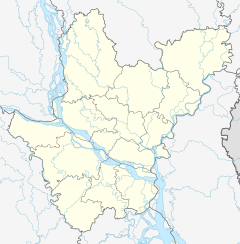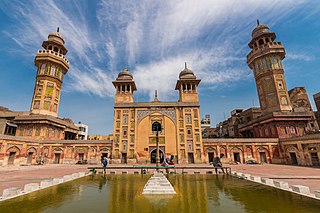
The Wazir Khan Masjid is a 17th-century Mughal masjid located in the city of Lahore, Punjab, Pakistan. The mosque was commissioned during the reign of the Mughal Emperor Shah Jahan as a part of an ensemble of buildings that also included the nearby Shahi Hammam baths. Construction of Wazir Khan Mosque began in 1634 C.E., and was completed in 1641. It is on the UNESCO World Heritage Tentative List.

Mughal architecture is the type of Indo-Islamic architecture developed by the Mughals in the 16th, 17th and 18th centuries throughout the ever-changing extent of their empire in the Indian subcontinent. It developed from the architectural styles of earlier Muslim dynasties in India and from Iranian and Central Asian architectural traditions, particularly Timurid architecture. It also further incorporated and syncretized influences from wider Indian architecture, especially during the reign of Akbar. Mughal buildings have a uniform pattern of structure and character, including large bulbous domes, slender minarets at the corners, massive halls, large vaulted gateways, and delicate ornamentation; examples of the style can be found in modern-day Afghanistan, Bangladesh, India and Pakistan.
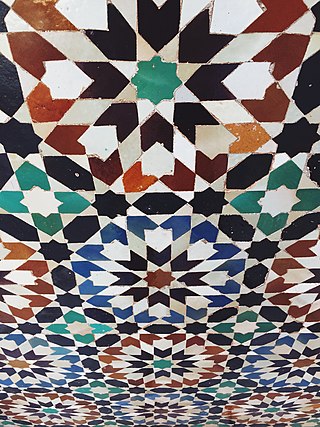
Zellij is a style of mosaic tilework made from individually hand-chiseled tile pieces. The pieces were typically of different colours and fitted together to form various patterns on the basis of tessellations, most notably elaborate Islamic geometric motifs such as radiating star patterns. This form of Islamic art is one of the main characteristics of architecture in the western Islamic world. It is found in the architecture of Morocco, the architecture of Algeria, early Islamic sites in Tunisia, and in the historic monuments of al-Andalus. From the 14th century onwards, zellij became a standard decorative element along lower walls, in fountains and pools, on minarets, and for the paving of floors.

The Bou Inania Madrasa or Bu 'Inaniya Madrasa is a madrasa in Fes, Morocco, built in 1350–55 CE by Abu Inan Faris. It is the only madrasa in Morocco which also functioned as a congregational mosque. It is widely acknowledged as a high point of Marinid architecture and of historic Moroccan architecture generally.

The Great Mosque of Herat or "Jami Masjid of Herat", is a mosque in the city of Herat, in the Herat Province of north-western Afghanistan. It was built by the Ghurids, under the rule of Sultan Ghiyath al-Din Muhammad Ghori, who laid its foundation in 1200 CE. Later, it was extended several times as Herat changed rulers down the centuries from the Kartids, Timurids, Mughals and then the Uzbeks, all of whom supported the mosque. The fundamental structure of the mosque from the Ghurid period has been preserved, but parts have been added and modified. The Friday mosque in Herat was given its present appearance during the 20th century.

Choto Shona Mosque is located in Chapai Nawabganj district of Bangladesh. The mosque is situated about 3 kilometres (1.9 mi) south of the Kotwali Gate and 0.5 kilometres (0.31 mi) to the south-east of the Mughal Tahakhana complex in the Firozpur Quarter.

The architecture of Dhaka is a confluence of many architectural styles. From the Sena temples built by Ballal Sen, to the Mughal architecture of the Mughals, to the Indo-Saracenic style of the colonial era, to 20th century steel and chrome of skyscrapers. Dhaka has a colonial core in the river port area, surrounded by progressively newer areas as one travels away from the Buriganga, punctuated with old temples, churches and mosques.

Bangsal is a Thana of Dhaka District in the Division of Dhaka, Bangladesh. It was formed in September 2009 from part of Kotwali Thana.

Darasbari Mosque is a historic mosque that was built in 1479 AD.
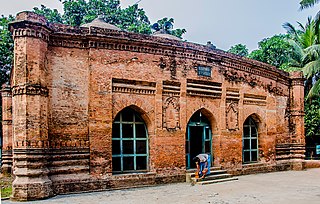
Baba Adam's Mosque is a mosque situated in the village of Qadi Qasbah under Rampal Union of Bangladesh's Munshiganj District. It was constructed in 1483 A.D by Malik Kafur to function as a Jami mosque during the reign of Jalaluddin Fateh Shah. The tomb of Baba Adam Shahid, a 15th-century Muslim preacher, lies near the edifice.

The Bibi Maryam Mosque, also known as the Hajiganj Mosque, is in Hajiganj, Narayanganj. The mosque is said to have been constructed by NawabShaista Khan, Mughal subadar of Bengal. The construction of the mosque began in 1664 and finished in 1688. It took 24 years to complete. Bibi Maryam, apparently his daughter, is said to be buried nearby in a tomb. The mosque is a three-domed type, the central dome being more comprehensive than the side ones. The side domes are reduced by thickening the side walls instead of adding an intermediate half-dome, as seen in some Mughal mosques. The basal leaf decoration of the domes and the battlemented merlons speak of the standard style. The panel leaf decoration on the top of the roof is seen only on the front side. The eastern facade of the mosque has the usual three arched entrances, each opening under a half dome and the central one being more expansive than the side entrances. Two windows, one each on the south and north sides are of later innovation. The four engaged corner towers, almost merged within the wall, are extended beyond the parapet. The interior hall shows simple lateral arches. The side bays are made square by thickening the side walls. The mosque has been repaired and renovated several times. It has significantly lost much of its original features through repairs since the corner towers are being wholly modernised. A veranda on masonry pillars on the eastern side has completely overshadowed the front view. It is now being used as a Jami mosque.
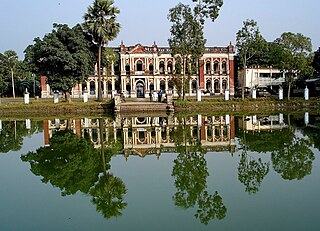
Murapara Rajbari is a well known palace in Rupganj Upazila of Narayanganj District, Bangladesh. The palace is situated in Murapara village, about 25 km southeast of Dhaka on the Narsindghi road. It is connected 5 km stretch of bumpy brick-paved feeder road on the west of main Dhaka- Sylhet trunk road.

The Goaldi Mosque is a mosque in the historic Bengali capital of Sonargaon. It was built during the Bengal Sultanate under the reign of Sultan Alauddin Hussain Shah. It is one of the few surviving medieval monuments in Sonargaon Upazila, Bangladesh.

Baro Shona Masjid also known as Baroduari Masjid, is located in Gour, West Bengal, India. Completed in 1526, it is situated half a kilometer to the south of Ramkeli, 12 km south from the city of Malda. The mosque with its ruins can be found very close to the India-Bangladesh border. With a gigantic rectangular structure of brick and stone, this mosque is the largest monument in Gour. Though the name means Twelve Doors, this monument actually has eleven.

The Kartalab Khan Mosque or Begum Bazar Mosque, in the Begum Bazar area in old Dhaka, Bangladesh, was built by Nawab Diwan Murshid Quli Khan between 1700 and 1704. The mosque consists of a high valuated platform, a mosque with a 'dochala' annex on the north upon the western half of the platform and a 'baoli' to the east of the platform. It is roofed by five domes resting on octagonal drums. The mosque was extensively renovated by Mirza Golam Pir in the nineteenth century. In accordance with Murshid Quli Khan's wishes, he was buried under the entrance to this mosque.
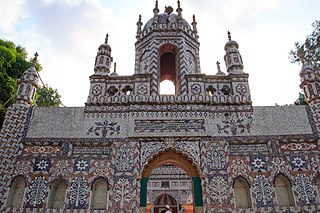
Bajra Shahi Mosque is an 18th-century mosque located in the Bazra Union under Sonaimuri Upazila of Noakhali District, Bangladesh. It has been described as the "most notable historical monument" in the area around Maijdee.

The Qassabtuly Mosque is one of the most ornate mosques in Old Dhaka, Bangladesh. It's gloriously inscribed decorations are delicate and one of a kind.

The Shrine of Khwaja Abd Allah, commonly called the Shrine at Gazur Gah and the Abdullah Ansari Shrine Complex, is the funerary compound of the Sufi saint Khwaja Abdullah Ansari. It is located at the village of Gazur Gah, three kilometers northeast of Herat, Afghanistan. The Historic Cities Programme of the Aga Khan Trust for Culture has initiated repairs on the complex since 2005.
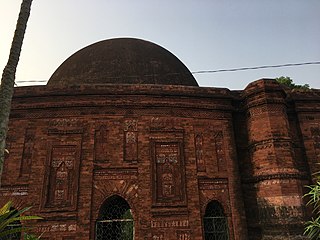
Shankarpasha Shahi Jame Masjid, is an ancient mosque in the Habiganj Sadar Upazila of Bangladesh. It was built during the 15th century. It is located in the village of Uchail Shankarpasha, Rajiura Union, Habiganj.

The tomb of the noble Isa Khan Niazi is located in the Humayun's Tomb complex in Delhi, India. The mausoleum, octagonal in shape and built mainly of red sandstone, was built in 1547–1548 during the reign of Sher Shah Suri. The mosque of Isa Khan is located west of the mausoleum, which along with other buildings form the UNESCO World Heritage Site of Humayun's tomb complex.


